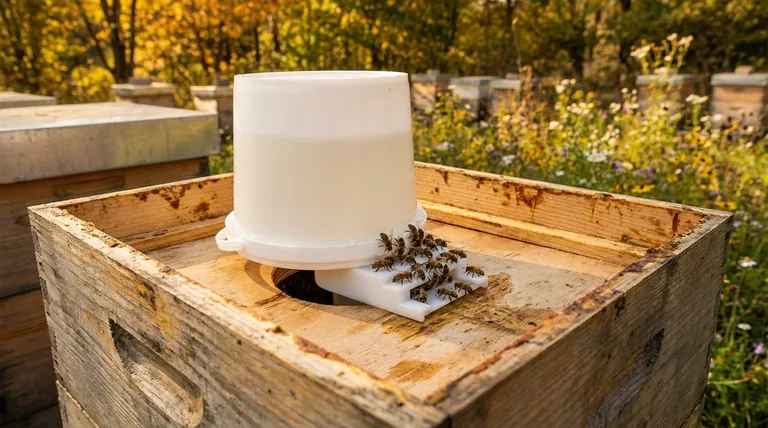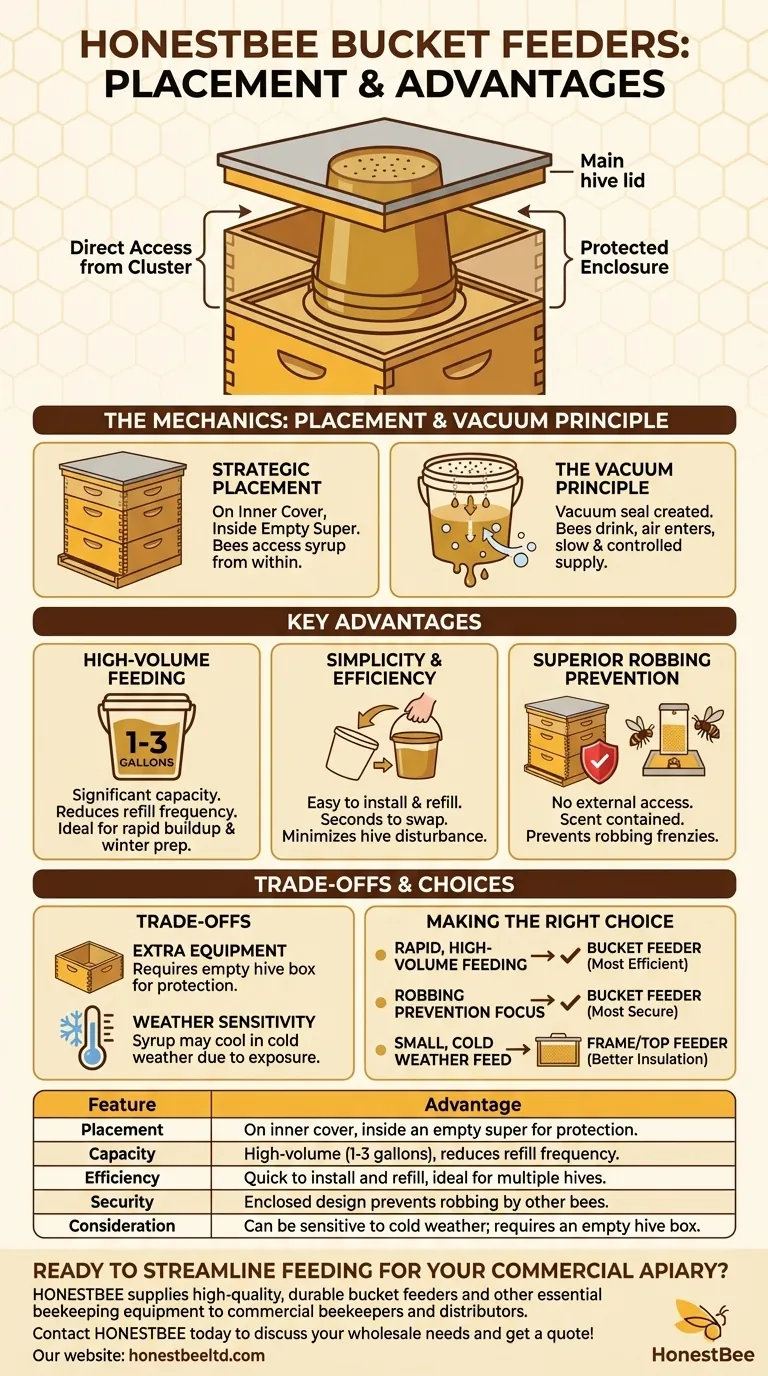At its core, a bucket feeder is a high-capacity feeding system placed directly on top of the hive's inner cover. Its primary advantages are its large volume, ease of installation, and its enclosed design, which offers excellent protection against robbing bees from other colonies.
The bucket feeder is the beekeeper's tool of choice for delivering large quantities of syrup efficiently and securely, making it ideal for rapid colony buildup or preparing multiple hives for winter.

The Mechanics of a Bucket Feeder
A bucket feeder is a simple yet effective tool that leverages basic physics to provide a steady supply of food to the colony. Understanding its placement and function is key to using it correctly.
Strategic Placement
The feeder is placed directly over the central hole of the hive's inner cover. This gives the bees direct access to the syrup from within the cluster, without having to leave the hive.
An empty hive box (a "super") is then placed around the bucket to protect it from the elements and pests before the main hive lid is put on top.
The Vacuum Principle
The feeder works by creating a vacuum seal. Small holes are drilled in the lid of the bucket. When the bucket is inverted over the hive, the vacuum prevents the syrup from pouring out all at once.
Bees consume the syrup from the holes, and as they do, small amounts of air enter the bucket, releasing more syrup to take its place. This ensures a slow, steady, and controlled supply.
Key Advantages Explained
The design of the bucket feeder offers several distinct benefits, particularly for beekeepers managing more than one or two colonies.
High-Volume Feeding
With capacities often ranging from one to three gallons, bucket feeders can hold a significant amount of syrup. This reduces the frequency of refills, saving you time and labor.
This is especially valuable during the fall when you need to get a large volume of heavy syrup into the hive quickly to build up winter stores.
Simplicity and Efficiency
Bucket feeders are exceptionally easy to install and refill. You can prepare the buckets ahead of time and simply swap an empty one for a full one.
This process takes only seconds and minimizes the time the hive is open, reducing disturbance and stress on the colony. When managing multiple hives, this efficiency is a major advantage.
Superior Robbing Prevention
Because the syrup is entirely enclosed within the hive stack, there is no external access for robber bees. The scent of syrup is contained, making your hive less of a target.
This is a critical advantage over external feeders (like entrance feeders), which can quickly incite a robbing frenzy that can decimate a weak colony.
Understanding the Trade-offs
While highly effective, bucket feeders are not without their considerations. Objectivity requires acknowledging their potential downsides.
Requires Extra Equipment
To properly house a bucket feeder, you need an empty deep or medium hive box to place on top of the inner cover. This serves as a protective shell for the bucket.
Weather Sensitivity
In cold weather, the syrup inside the bucket can become too cold and thick for the bees to consume. Because it sits at the top of the hive, it is more exposed to ambient air temperature.
Making the Right Choice for Your Goal
Selecting a feeder depends entirely on your specific objective for the colony at that moment.
- If your primary focus is rapid, high-volume feeding: The bucket feeder is the most efficient and practical choice, especially for fall feeding or managing a large apiary.
- If your primary focus is preventing robbing at all costs: The enclosed design of a bucket feeder makes it one of the most secure options available.
- If your primary focus is small, supplemental feeding in cold weather: An internal frame feeder or top feeder that is better insulated by the hive body might be a more suitable option.
Ultimately, understanding the bucket feeder's strengths allows you to use it as a powerful tool for building strong, healthy, and productive colonies.
Summary Table:
| Feature | Advantage |
|---|---|
| Placement | On the inner cover, inside an empty super for protection. |
| Capacity | High-volume (1-3 gallons), reduces refill frequency. |
| Efficiency | Quick to install and refill, ideal for multiple hives. |
| Security | Enclosed design prevents robbing by other bees. |
| Consideration | Can be sensitive to cold weather; requires an empty hive box. |
Ready to streamline feeding for your commercial apiary?
HONESTBEE supplies high-quality, durable bucket feeders and other essential beekeeping equipment to commercial beekeepers and distributors through our wholesale-focused operations. Our products are designed for efficiency and reliability, helping you build stronger colonies with less labor.
Contact HONESTBEE today to discuss your wholesale needs and get a quote!
Visual Guide

Related Products
- Classic Boardman Entrance Bee Feeder Hive Front Feeding Solution
- HONESTBEE Professional Hive Top Bee Feeder Feeding Solution
- HONESTBEE Entrance Bee Feeder Professional Hive Nutrition Solution for Beekeeping
- HONESTBEE Round Hive Top Bee Feeder for Syrup
- HONESTBEE Entrance Bee Feeder Efficient Hive Front Liquid Feeding Solution for Beekeeping
People Also Ask
- How do you make an entrance feeder for bees? A Guide to Safe & Effective Hive Feeding
- What are the different types of honey bee feeders? Choose the Right Feeder for Your Hive
- What types of bee feeders are available for beginners? Start with the Simple Entrance Feeder
- How can a Boardman Feeder be used to provide water to bees? Avoid These Critical Risks to Your Hive
- How to make an entrance feeder for bees? A DIY Guide for Safe & Effective Feeding



















